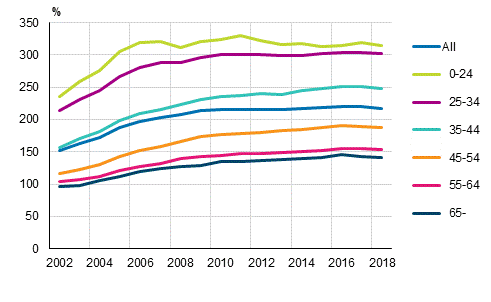Published: 20 March 2020
Average housing loans of household-dwelling units with housing loans EUR 100,030
In 2018, the debt-to-income ratio of household-dwelling units with housing loans was, on average, 217 per cent. Debts relative to income were highest for household-dwelling units of those aged under 35, whose debts were slightly over triple their disposable annual monetary income. On average, the housing loan of household-dwelling units with housing loans amounted to EUR 100,030, which was 0.2 per cent more than in 2017.
Rates of indebtedness of household-dwelling units with housing loans by the age of the reference person in 2002–2018, %

In 2018, there were 1.4 million indebted household-dwelling units, that is, 53 per cent of all household-dwelling units. Their total debt amounted to EUR 123 billion, which in real terms was 0.6 per cent more than in the previous year. The number of indebted household-dwelling units has gone up by eleven per cent and debts have grown in real terms by 118 per cent since 2002.
The disposable monetary income of household-dwelling units grew in total by 2.2 per cent from the previous year, that is, more than debts, so the indebtedness rate of household-dwelling units fell slightly. In 2018, the indebtedness rate of all household-dwelling units was 111 per cent, while it was 112 per cent in the year before.
Of debts, EUR 87.8 billion or 71 per cent were housing loans. Around one third of all household-dwelling units or 877,500 had housing loans. Housing loans grew by 0.1 per cent from the previous year. Housing loans do not include shareholders’ share of housing company loans. In all, 84,400 household-dwelling units had debts taken out for business purposes amounting to EUR 8.2 billion, which was 9.7 per cent more than in the previous year. Household-dwelling units’ other debts amounted to EUR 27.0 billion, 0.2 per cent less than in the year before. Other debts include study loans and loans taken out for consumption or large purchases, such as a car or holiday home.
For almost one-fifth of indebted household-dwelling units, that is, 263,530, debts were at least three times as high as their disposable annual income. They held 48 per cent of all household-dwelling units' debts. In all, 64,240 household-dwelling units or 4.5 per cent of indebted household-dwelling units had debts that were at least five times as high as their annual income. They held 17 per cent of all household-dwelling units' debts.
Two-supporter household-dwelling units with children where the reference person was aged 25 to 44 had a lot of debt compared to their disposable income. Large debts were most common for childless one or two-adult household-dwelling units aged 25 to 34. Single supporters with housing loans also had much debt compared to income.
Large housing loans were found most in household-dwelling units living in Åland, Greater Helsinki and elsewhere in Helsinki-Uusimaa. In all, 42 per cent of household-dwelling units with housing loans in Åland, 37 per cent in Greater Helsinki and 33 per cent elsewhere in Helsinki-Uusimaa had debts that were at least triple compared with their annual income. The number of large housing loans was lowest in Northern and Eastern Finland, where nearly one quarter of household-dwelling units with housing loans had that much debt.
Of the household-dwelling units belonging to the lowest income quintile, 42 per cent had debts that were at least triple compared with their annual income, while 24 per cent of the household-dwelling units in the highest income quintile had that much debt. Household-dwelling units belonging to the lowest income quintile had an average of EUR 64,480 in housing loans and those in the highest income quintile EUR 130,920.
Household-dwelling units paid EUR 1.7 billion in interests in 2018. The interest expenses of household-dwelling units decreased by 0.1 per cent from the previous year. From 2002 to 2018, household-dwelling units’ interest expenses have diminished in real terms by 43 per cent, while their debts have more than doubled during the same period. Of indebted household-dwelling units, 60 per cent, or 858,700, paid at most EUR 1,000 in interests and three per cent, or 38,800 household-dwelling units over EUR 5,000.
Source: Indebtedness 2018. Statistics Finland
Inquiries: Auli Hämäläinen 029 551 3615, Timo Matala 029 551 3422
Director in charge: Jari Tarkoma
Publication in pdf-format (170.7 kB)
- Tables
-
Tables in databases
Pick the data you need into tables, view the data as graphs, or download the data for your use.
Updated 20.3.2020
Official Statistics of Finland (OSF):
Indebtedness [e-publication].
ISSN=2489-3285. 2018. Helsinki: Statistics Finland [referred: 24.12.2025].
Access method: http://stat.fi/til/velk/2018/velk_2018_2020-03-20_tie_002_en.html

